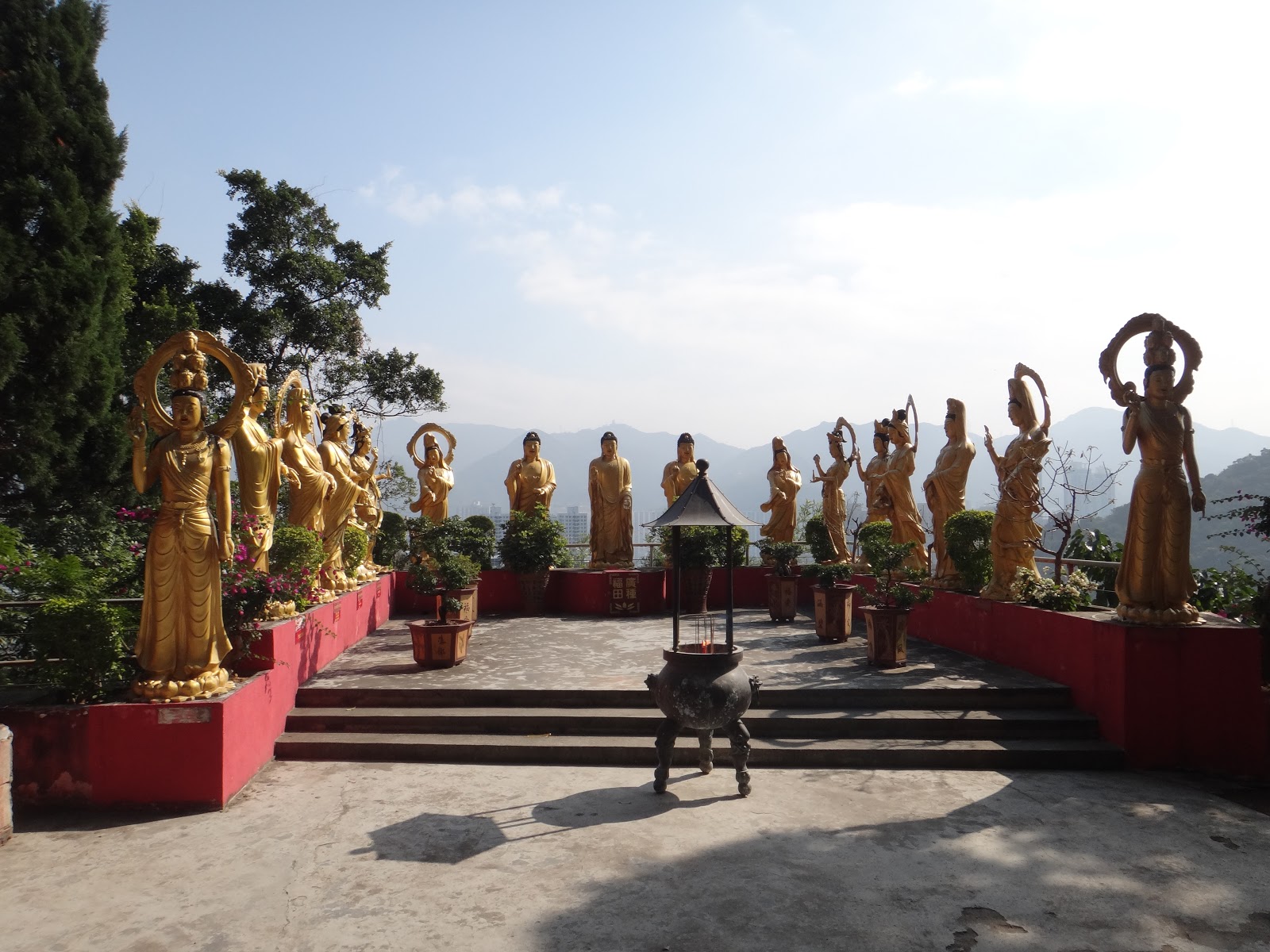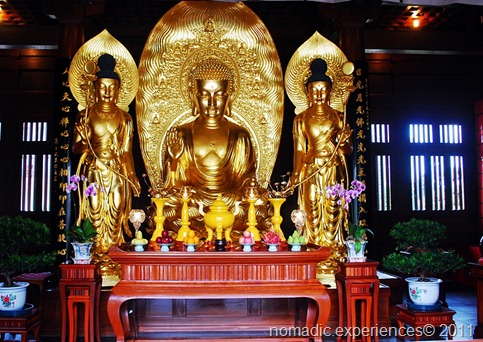Greetings all!
As I have previously mentioned in my posts, Hong Kong consists of three main areas: Hong Kong Island, Kowloon and the New Territories. We have explored so much on HK Island and Kowloon that we decided it was time to go deep into the country to explore the New Territories. This area which accounts for over 80% of the land in Hong Kong is home to more than 3.5 million people. Much of the land out here is reserved as parkland which is a nice change from the urban jungle we are living in every day.
Our destination was a town called Sha Tin. Sha Tin is located in a valley, on both sides of the Shing Mun River. The first place we visited was the Ten Thousand Buddhas Monastery. The monastery actually has close to 13,000 Buddhas in all shapes and sizes. It is located at the top of a steep hill with about a 500 step climb.
Lucky for us, it was a beautiful, sunny day as we set out to tackle these stairs.
After about ten minutes of walking, you come to the entrance and the walkway is then lined with Buddhas all the way up to the top. Here is the view looking down the hill.
We had heard that out in the mountains you might see Macaques. We had barely started climbing, when we saw one in the trees! Zack was able to get a quick picture of him after which time, we quickly moved along. We didn't want to make the monkey angry! We later saw signs warning us not to upset the monkeys.
Here is a random selection of the Buddhas we saw on our climb up.
After about 20 minutes of stair climbing, we reached the top! In addition to all the Buddhas, there is a 9-story pagoda and many places to worship.
Some of the Budhhas had what looked like a swastika painted on them. We've seen this at other temples as well. Because of the symbols most recent history, it is somewhat disconcerting to see this. What I didn't know - prior to my time in Asia - was that this symbol was used in ancient civilizations around the world. It remains widely used in Hinduism, Buddhism, and Jainism, primarily as a symbol of auspiciousness. In countries such as Taiwan, Japan, Hong Kong, Korea and China itself, the symbol is most commonly associated with Buddhism. They could be commonly found in Buddhist temples, religious artifacts, texts related to Buddhism and schools founded by Buddhist religious groups.
There were some great views from the top. It was definitely worth the climb!
A common occurrence in our neighborhood is seeing fake monks begging money from tourists - primarily they approach Caucasian people. We have been approached many time while we've been here. Apparently, they have that problem out here as well as they have signs warning you about them.
Here is a selection of Buddhas from our walk down the hill on a different path.
Our next stop was Sha Tin Park. This was a pretty park along the riverfront area. There was a walking and a biking path along the river that was very popular.
They had some really cute trash cans.
The park also had some decorations for the upcoming Chinese New Year celebrations. This is going to be the Year of the Snake. Some of the decorations seemed to have a bit of a Christmas vibe to them though...
We also randomly see across Hong Kong, displays from the Beijing Olympics in 2008.
Our last stop was the Hong Kong Heritage Museum. The best part of this museum was a display of works done by a Chinese artist, Gao Qifeng and others who painted in a similar style. The paintings were beautiful. Here are some examples of the work.

Once we finished the museum we were quite tired and decided it was time to head home. Until next time!
Carla
As I have previously mentioned in my posts, Hong Kong consists of three main areas: Hong Kong Island, Kowloon and the New Territories. We have explored so much on HK Island and Kowloon that we decided it was time to go deep into the country to explore the New Territories. This area which accounts for over 80% of the land in Hong Kong is home to more than 3.5 million people. Much of the land out here is reserved as parkland which is a nice change from the urban jungle we are living in every day.
Our destination was a town called Sha Tin. Sha Tin is located in a valley, on both sides of the Shing Mun River. The first place we visited was the Ten Thousand Buddhas Monastery. The monastery actually has close to 13,000 Buddhas in all shapes and sizes. It is located at the top of a steep hill with about a 500 step climb.
Lucky for us, it was a beautiful, sunny day as we set out to tackle these stairs.
 |
| Are we there yet??? |
After about ten minutes of walking, you come to the entrance and the walkway is then lined with Buddhas all the way up to the top. Here is the view looking down the hill.
 |
| Time to stop for a rest |
We had heard that out in the mountains you might see Macaques. We had barely started climbing, when we saw one in the trees! Zack was able to get a quick picture of him after which time, we quickly moved along. We didn't want to make the monkey angry! We later saw signs warning us not to upset the monkeys.
Here is a random selection of the Buddhas we saw on our climb up.
After about 20 minutes of stair climbing, we reached the top! In addition to all the Buddhas, there is a 9-story pagoda and many places to worship.
Some of the Budhhas had what looked like a swastika painted on them. We've seen this at other temples as well. Because of the symbols most recent history, it is somewhat disconcerting to see this. What I didn't know - prior to my time in Asia - was that this symbol was used in ancient civilizations around the world. It remains widely used in Hinduism, Buddhism, and Jainism, primarily as a symbol of auspiciousness. In countries such as Taiwan, Japan, Hong Kong, Korea and China itself, the symbol is most commonly associated with Buddhism. They could be commonly found in Buddhist temples, religious artifacts, texts related to Buddhism and schools founded by Buddhist religious groups.
There were some great views from the top. It was definitely worth the climb!
A common occurrence in our neighborhood is seeing fake monks begging money from tourists - primarily they approach Caucasian people. We have been approached many time while we've been here. Apparently, they have that problem out here as well as they have signs warning you about them.
Here is a selection of Buddhas from our walk down the hill on a different path.
 |
| This one had similar facial hair to Zack |
Our next stop was Sha Tin Park. This was a pretty park along the riverfront area. There was a walking and a biking path along the river that was very popular.
They had some really cute trash cans.
The park also had some decorations for the upcoming Chinese New Year celebrations. This is going to be the Year of the Snake. Some of the decorations seemed to have a bit of a Christmas vibe to them though...
 |
| Year of the Snake or something else? |
We also randomly see across Hong Kong, displays from the Beijing Olympics in 2008.
Our last stop was the Hong Kong Heritage Museum. The best part of this museum was a display of works done by a Chinese artist, Gao Qifeng and others who painted in a similar style. The paintings were beautiful. Here are some examples of the work.
Once we finished the museum we were quite tired and decided it was time to head home. Until next time!
Carla


























































































